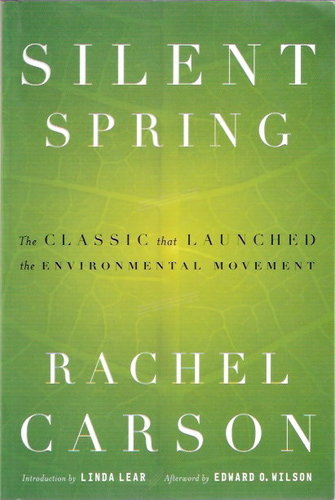It is not my contention that chemical insecticides must never be used. I do contend that we have put poisonous and biologically potent chemicals indiscriminately into the hands of persons largely or wholly ignorant of their potentials for harm. We have subjected enormous numbers of people to contact with these poisons, without their consent and often without their knowledge. If the Bill of Rights contains no guarantee that a citizen shall be secure against lethal poisons distributed either by private individuals or by public officials, it is surely only because our forefathers, despite their considerable wisdom and foresight, could conceive of no such problem.
--Rachel Carson, Silent Spring, p. 32
Rachel Carson’s writings were so important that they launched the all-out warfare of the anti-environmental, corporate elite against her. She has been accused of the deaths of millions, when the exact opposite is true. They accuse her of things that are patently false: that DDT was banned worldwide; that the reason there are malaria deaths is that DDT was banned, rather than that mosquitoes acquired resistance; that DDT is largely innocuous. Carson’s Silent Spring is one of those rare things: a nexus where the forces of good and evil meet and battle.
Carson argues that the pesticides used willy-nilly after World War II to control pests were causing untold damage to the natural world, including wildlife, soil health, general ecological communities, and humans themselves. She substantiates her evidence carefully, with scientific sources meticulously noted at the end, and it’s amazing how many of her claims have been borne out over the years by further research. Her claims that pesticides are responsible for widespread death and destruction have only been vindicated in the years since she wrote. If only we had heeded her warning.
Carson really assumes very little in readers – only that they would not wish wildlife and livestock to die – and that they would not wish to risk their own lives – for nothing. The book is an excellent primer in ecological principles. Her argument has held up so well over the years that I think there is not one person who would not benefit to some degree from reading Silent Spring; and the book has more to offer than expected for those already inculcated with ecological principles and familiar with her argument.
We have experienced first-hand in our family the consequences of the failure of the general public to accept Carson’s findings. Our daughter Katherine died because of mosquito spraying with chlorpyrifos, an organophosphate. We never thought anyone would be so stupid as to spray pesticides up and down residential streets. Everyone we knew viewed the antiquated newsreels of trucks spraying children with DDT with a sort of condescending pity at their ignorance. Hadn’t we realized that with Carson? Silent Spring roused consciousness of the horror of killing all living creatures in the name of assassinating some bugs. In fact, the practice of mosquito spraying remains surprisingly widespread.
There is no question that women of childbearing age, children, and babies in utero continue to be exposed to pesticides and many other toxic chemicals, at rates that dwarf that of the 1960’s, when Carson was writing. The Environmental Working Group (EWG) has made a superb video called 10 Americans illuminating this issue, easily found with a Google or YouTube search. Updated in 2012, the video discusses testing for 413 different toxic chemicals that EWG performed on the blood of 10 Americans in 2004. Says Ken Cook, President of EWG,
None of these ten Americans were exposed to these chemicals by virtue of the air that they breathe, even though we found some of these very chemicals in these 10 people. It could have also been the water they drank,…but we know for a fact that it wasn’t the tap water. Of course, it could have been food that was the route of exposure, but we know for a fact that none of these 10 Americans were exposed to the chemicals we found as a result of food that they bought at the grocery store…. These 10 Americans weren’t farmworkers, they weren’t factory workers,… And when the results had come back from the laboratory, we had found 287 of these chemicals in just those 10 people, an average of 200 chemicals in each one.
The punch line is that the 10 Americans were newborns. The blood tested was umbilical cord blood. The exposures were all prenatal, and this was the first time that someone had bothered to sample cord blood for these toxicants. As Cook points out, babies before they are born do not have a blood-brain barrier; there is no protection for the fetus’s brain from these chemicals. Previously, it had been thought that the placenta might have provided protection, but the EWG test showed that no significant protection exists. One of those tested was Ken Cook’s own infant, and he chokes up on camera at that fact, though as far as we know his child is still perfectly healthy. Students who watch this video and read Carson are shocked and appalled, as they should be, and they always want to know if the babies who had been surveyed in the video were OK, as though only these particular babies were at risk. This is a more complicated question than it sounds, and I’m not always sure how to answer. None of the children, as far as we know, has been diagnosed with cancer, though it is true that babies are sometimes born with cancer, most likely from in utero exposures (Goncalves et al. 2010; Katic et al. 2010; Emerenciano et al. 2007; Ferreira et al. 2013). Babies with AML (acute myelogenous leukemia) are more than five times more likely to have the disease if exposed to pesticides in utero and seven times more likely to have AML if their mothers were breast feeding and exposed (Ferreira et al. 2013). I will never forget baby Maggie with leukemia, getting a transplant down the hall from Katherine. But the point of this is that while none of these babies were yet diagnosed with disease, they are not really OK either, and neither is any child now born, if by OK you mean unaffected and likely to remain unaffected by the toxic exposures throughout their lifetimes. The fact is, we just don’t know, but it seems likely that the children are much less OK than if they had been born without these toxic exposures, as Carson surmised decades ago.
The link between pesticides and other environmental chemicals and autism is more recent, but increasingly a stronger correlation than mercury, particularly with organophosphate or organochlorine pesticides (Roberts 2007; Landrigan 2010; Schwartzer 2013). It is early days for considering mechanisms by which these chemicals change a fetus’s brain, but the best guess right now is that the chemicals affect either detoxification systems (Woodward et al., 2001), the ways by which the body naturally clears itself of toxic substances, or the signaling systems neurons use to talk to each other (Stamou et al. 2013), or both. Organophosphate pesticides have long been known to be ruinous to the nervous system. Indeed, they were developed during the World Wars precisely for that purpose: they were initially meant to be used as weaponized nerve gas. It must have seemed pretty handy that they could be retrofitted as pesticides; certainly, the companies involved would have wished to continue making money from processes they already had set up. Because they were imagined first as weapons, these substances were never tested for safety. Carson showed long ago how really toxic pesticides like DDT were, yet the use of these chemicals has only gone up by volume. In the most recent year for which there is data, 2001, 73 million pounds of organophosphate pesticides were used, in the United States alone (Kiely et al. 2004). That’s about a quarter pound of this one type of chemical for every man, woman, and child in the country. Over a billion pounds of pesticides total are used every year in the United States, not including pesticides used in paints, plastics, or preserved woods. If these applications were included, the total would be 4 billion (Goldman 2000). Yet people are sensitive to very low levels. Organophosphate pesticides have been found in the blood and urine of nearly every child tested in the U.S. (Barr et al. 2005), which, as with so many of our synthetic chemicals, makes a control group impossible. This information is publicly available through the CDC Biomonitoring Project online. Everyone should read the executive summary.
Not so much is new in the science since Rachel Carson, though much has been confirmed; nor have our practices changed for the better. But I'll tell you what is new since 1962, when Silent Spring was published: my babies, and millions more like them. Our sweet Katherine will never get another chance at life, just like the thousands of other children who have died of cancer or dealt with debilitating disease – cancer, autism, ADHD, asthma, diabetes, autoimmune disease – since that time. Her story is not singular, but representative. Nothing has changed during that time, not for lack of solutions, but for lack of will, or perhaps because those few corporations who make money off externalizing the costs of these chemicals fiercely buttress business as usual and have perverted the political process and diverted the stream of scientific knowledge along the way.
References
Carson, R. (2002). Silent spring: Fortieth anniversary edition. New York: Houghton Mifflin.
Emerenciano, M., Koifman, S., Pombo-de-Oliveira, M.S. (2007). Acute leukemia in early childhood. Brazilian Journal of Medical and Biological Research 40: 749-760.
Environmental Working Group (EWG). (2012). 10 Americans. http://www.ewg.org/news/videos/10-americans
Goldman, L.R., Kodurum S. (2000). Chemicals in the environment and developmental toxicity to children: A public health and policy perspective. Environ Health Perspect 108 (3): 443-448.
Goncalves, B.A.A., Vasconcelos, G.M., Emerenciano, M., Koifman, S., Pombo-de-Oliveira, M.S. (2010). NQ01 polymorphism, maternal exposure and the risk of infant leukemia. EJC Supplements 8 (5): 5-81.
Katic, J., Fucic, A., Gamulin, M. (2010). Prenatal, early life, and childhood exposure to genotoxicants in the living environment. Arh Hig Rada Toksikol 61: 455-464.
Kiely, T., Donaldson, D., Grube, A. (2004). Pesticides industry sales and usage: 2000 and 2001 market estimates. Washington DC: US EPA.
Landrigan, P. (2010). What causes autism? Exploring the environmental contribution. Current Opinion in Pediatrics 22: 219-225.ß
Roberts, E.M., English, P.B., Grether, J.K., Windham, G.C., Somberg, L., Wolff, C. (2007). Maternal residence near agricultural pesticide applications and autism spectrum disorders among children in the California Central Valley. Environ Health Perspect 115 (10): 1482-1489.
Schwartzer, J.J., Koenig, C.M., Berman, R.F. (2013). Using mouse models of autism spectrum disorders to study the neurotoxicology of gene-environment interactions. Neurotoxicology and Teratology 36: 17-35.
Stamou, M., Streifel, K., Goines, P., Lein, P. (2013). Neuronal connectivity as a convergent target of gene x environment interactions that confer risk for Autism Spectrum Disorders. Neurotoxicology and Teratology 36: 3-16.
Woodward, G. (2001). Autism and Parkinson’s disease. Medical Hypotheses 56 (2): 246-249.












